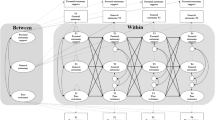Abstract
A path-analytic model was employed to examine relations between parent-reported instrumental and expressive traits, child-reported parental acceptance, and adolescent self-esteem and self-consciousness. Analyses were run separately for each parent-child dyad. It was predicted that any relations between parental traits and child adjustment would be mediated by parental acceptance, especially for expressive traits. This prediction was confirmed for families with daughters. The findings suggest, for the daughter dyads, that parents with expressive traits are more likely to communicate acceptance which, in turn, fosters child adjustment. Of the total variance accounted for in the child adjustment indices, most was due to the contribution of parental acceptance to the model. A comparison of these results with those of previous studies suggests that relations between parental traits and the other variables in the path model are less dramatic when parents' report of their own personality characteristics are employed than when child report is employed. Future research may be improved by serious consideration of mediating variables rather than examining relations between distally-related parent and child variables.
Similar content being viewed by others
References
Baumrind, D. Are androgynous individuals more effective persons and parents? Child Development, 1982, 53, 44–75.
Bell, A. P., Weinberg, M. S., & Hammersmith, S. K. Sexual preference: Its development in men and women. Bloomington, Ind. Indiana University Press, 1981.
Bem, S. L. The measurement of psychological androgyny. Journal of Consulting and Clinical Psychology, 1974, 42, 155–162.
Bem, S. L. Sex role adaptability: One consequence of psychological androgyny. Journal of Personality and Social Psychology, 1975, 31, 634–643.
Bem, S. L., & Lenney, E. Sex typing and the avoidance of cross-sex behavior. Journal of Personality and Social Psychology, 1976, 33, 48–54.
Bem, S. L., Martyna, W., & Watson, C. Sex typing and androgyny: Further examination of the expressive domain. Journal of Personality and Social Psychology, 1976, 34, 1016–1023.
Bronfenbrenner, U. Toward a theoretical model for the analysis of parent-child relationships in a social context. In J. C. Glidewell (Ed.), Parental attitudes and child behavior. Springfield, Ill.: Charles C. Thomas, 1961.
Child, I. L. Personality. Annual Review of Psychology, Palo Alto: Annual Reviews, 1954, 5, 149–170.
Cohen, J., & Cohen, P. Applied multiple regression/correlation analysis for the behavioral sciences. Hillsdale, N.J: Erlbaum, 1983.
Coopersmith, S. The antecedents of self-esteem. San Francisco, Calif.: W. H. Freeman, 1967.
Duncan, O. D. A socioeconomic index for all occupations. In A. J. Reiss, Jr. (Ed.), Occupations and social status. New York: Arno Press, 1977.
Hall, J. A., & Taylor, M. C. Psychological androgyny and the MxF interaction. Journal of Personality and Social Psychology, 1985, 49, 429–435.
Harter, S. Developmental perspectives on the self-system. In P. H. Mussen (Ed.), Handbook of child psychology (Vol. 4). New York: John Wiley & Sons, 1983.
Helmreich, R. L., Spence, J. T., & Holahan, C. K. Psychological androgyny and sex role flexibility: A test of two hypotheses. Journal of Personality and Social Psychology, 1979, 37, 1631–1644.
Hill, J. P., & Lynch, M. E. The intensification of gender-related role expectations during early adolescence. In J. Brooks-Gunn & A. C. Petersen (Eds.), Girls at puberty. New York: Plenum, 1983.
Kim, J., & Kohut, F. J. Special topics in general linear models. In N. H. Nie, C. H. Hull, J. G. Jenkins, K. Steinbreuner, D. H. Brent (Eds.), Statistical package for the social sciences (2nd ed.). New York: McGraw-Hill, 1975.
Lubinski, D., Tellegen, A., & Butcher, J. N. The relationship between androgyny and subjective indicators of emotional well-being. Journal of Personality and Social Psychology, 1981, 40, 722–730.
Lubinski, D., Tellegen, A., & Butcher, J. N. Masculinity, femininity, and androgyny viewed and assessed as distinct concepts. Journal of Personality and Social Psychology, 1983, 44, 428–439.
Maccoby, E. E. Social development: Psychological growth and the parent-child relationship. New York: Harcourt Brace Jovanovich, 1980.
Martin, B. Parent-child relations. In F. D. Horowitz (Ed.), Review of child development research (Vol. 4). Chicago, Ill.: University of Chicago Press, 1975.
Nie, N. H., Hull, C. H., Jenkins, J. G., Steinbreuner, K., & Brent, D. H. (Eds.). Statistical package for the social sciences (2nd ed.). New York: McGraw-Hill, 1975.
Rosenberg, M. Society and the adolescent self-image. Princeton, N.J.: Princeton University Press, 1965.
Runyon, R. P., & Haber, A. Fundamentals of behavioral statistics (5th Ed.). Reading, Mass.: Addison-Wesley, 1984.
Schaefer, E. S. A circumplex model for maternal behavior. Journal of Abnormal and Social Psychology, 1959, 59, 226–235.
Shantz, C. H. Social cognition. In P. H. Mussen (Ed.), Handbook of child psychology (Vol. 3). New York: John Wiley & Sons, 1983.
Simmons, R. G., & Rosenberg, F. Sex, sex roles, and self-image. Journal of Youth and Adolescence, 1975, 4, 229–258.
Simmons, R. G., Rosenberg, F., & Rosenberg, M. Disturbance in the self-image at adolescence. American Sociological Review, 1973, 38, 553–568.
Sonquist, J., Baker, E., & Morgan, J. Searching for structure. Ann Arbor Mich.: Institute for Social Research, University of Michigan, 1973.
Spence, J. T., & Helmreich, R. L. Masculinity and femininity: Their psychological dimensions, correlates and antecedents. Austin, Tex.: University of Texas Press, 1978.
Spence, J. T., Helmreich, R. L., & Stapp, J. The Personal Attributes Questionnaire: A measure of sex role stereotypes and masculinity-femininity. Journal Supplement Abstract Service Catalog of Selected Documents in Psychology, 1974, 4, 43. (Ms. No. 617).
Wiley, R. C. The self-concept: Volume 2. Theory and research on selected topics (Rev. Ed.). Lincoln, Nebr. University of Nebraska Press, 1979.
Author information
Authors and Affiliations
Additional information
The research reported here was supported by Father Flanagan's Boys Home, Inc., by a grant from the John D. and Catherine T. MacArthur Foundation, “Family Relations in Early Adolescence,” and by a Graduate School Research Fellowship awarded to the senior author from Virginia Commonwealth University. The authors are grateful to Karl Kelley for his statistical advice.
Rights and permissions
About this article
Cite this article
Holmbeck, G.N., Hill, J.P. A path-analytic approach to the relations between parental traits and acceptance and adolescent adjustment. Sex Roles 14, 315–334 (1986). https://doi.org/10.1007/BF00287582
Issue Date:
DOI: https://doi.org/10.1007/BF00287582




